This is an Argus V-100, a 35mm rangefinder camera made in Hamburg, West Germany by Iloca for the American company Argus between the years 1958 and 1959. The V-100 was also sold as the Iloca Rapid IIL and the Sears Tower 52. The Argus V-100 has a coupled rangefinder and uncoupled selenium exposure meter. Although featuring a fixed lens, it could be had with one of two lenses, this one having the better 48mm Cintagon II f/2 lens. For Argus, who had previously produced their own cameras, the Argus V-100 was unique in the company’s line up, offering German quality and precision with a name familiar to Americans.
Film Type: 135 (35mm)
Lens: 48mm f/2 Argus Cintagon II coated 6-elements in 4-groups
Focus: 2.6 feet to Infinity
Viewfinder: Coincident Image Coupled Rangefinder
Shutter: Synchro-Compur Leaf
Speeds: B, 1 – 1/500 seconds
Exposure Meter: Uncoupled Selenium Cell w/ top plate display
Battery: None
Flash Mount: Hot shoe and M and X Flash Sync
Other Features: Self-Timer
Weight: 636 grams
Manual: https://www.cameramanuals.org/argus/argus_v-100.pdf
How these ratings work |
The Argus V-100 is an interesting German camera sold by an American company. This version comes with a good Synchro-Compur shutter and excellent Rodenstock built lens, but beyond that, the camera is a mess with strange ergonomics, a very tiny viewfinder, features that were outdated at the camera’s 1958 release date, and one of the worst implementations of how to open a film compartment I’ve ever seen. I really wanted to like this camera, but I couldn’t. | ||||||
| Images | Handling | Features | Viewfinder | Feel & Beauty | History | Age | |
| 2 | 1 | 1 | 0 | 1 | 0 | 30% | |
| Bonus | none | ||||||
| Final Score | 6.5 | ||||||
History
For some, the idea that a German camera would be sold by Argus might seem strange, but to those who know the whole history of Argus, it’s not as strange as you might think. Of all the American camera makers who saw success after the war, Argus was positioned best to lead the American camera industry as the company’s most popular model, the C3 was selling really well, profits were soaring, and the company was hot off lucrative contracts with the US Government for wartime production.
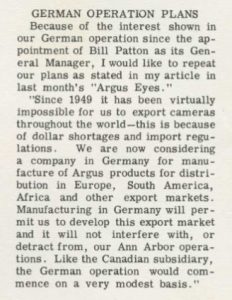
In the early 1950s, with the rise of the Japanese camera industry and resumption of Germany’s prewar successes, American companies found themselves struggling to compete with the number of high quality, and increasingly cheaper cameras available. In the October 1954 issue of Argus’s company newsletter, “Argus Eyes”, editor Robert E. Lewis states a new office in Stuttgart, Germany would commence building cameras under the Argus name for export. In a later issue of Argus Eyes, Smith further clarifies that with labor rates of 26 cents per hour in Japan and 37 cents per hour in Germany, it is very difficult to compete with labor costs compared to Argus’s average salary of $2.50 per hour, thus further justifying the need to do some business in other countries.
In my research for the Argus SLR from 1960 that was produced in Japan by Mamiya, I mentioned that a prototype for an all new Argus SLR was in the works in Stuttgart that was an all new design. Exactly how far along Argus got on that project is unclear as I’ve never seen any photos or found any conclusive evidence that the project was ever completed. The Stuttgart office was managed by Argus employee Bill Patton from 1955 until around 1957 when it was closed down.
Exactly what went wrong with the German Argus office is not clear, but it at least set the stage for the company to have future interest in the German camera industry. Perhaps as an outcome of the failure of the Stuttgart office, in 1958, Argus would release a German made Argus rangefinder camera produced in Hamburg, Germany by Iloca.
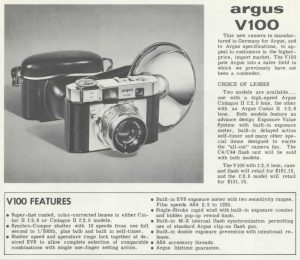
Although a rebadged 35mm rangefinder is a far cry from an all new SLR design, perhaps it was seen by the company as an acceptable consolation as in March 1958, the company proudly released their new German camera, the Argus V-100.
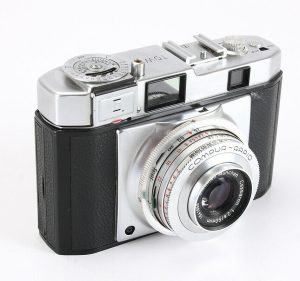
The Argus V-100 was a rebadged Iloca Rapid IIL which had already been in production for at least a year, and was also sold by Sears Roebuck & Company as the Tower 52.
The Argus V-100 was compact and had good build quality, a high quality Synchro-Compur leaf shutter, and was offered with one of two lenses, a 52mm Argus Cintar II f/2.8 or a 48mm Argus Cintagon II f/2 lens. Each lens was produced by Steinheil and Rodenstock respectively.
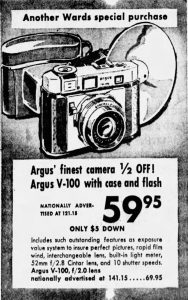
When it was first released, retail prices for the two versions of the new Argus camera were $161.15 and $131.15, which when adjusted for inflation, compare to around $1300 and $1580 today, making them the most expensive Argus branded cameras ever made. For comparison, in the 1959 Sears Catalog, the Argus C3 Match-Matic rangefinder had a retail price of $59.95, almost one third that of the more expensive V-100. It would seem that Argus quickly realized these prices were far too high as within a year, the prices sank to a much more reasonable $69.95 and $59.95.
Exactly how successful the Argus V-100 was is unclear, but it’s pretty safe to say “not very”. As I write this, a quick search of eBay shows 3 for sale in both US and International versions of the site. I found no reviews or mention of the camera in any of the available major photography publications from that era. The only marketing material I could find for it were in regional newspaper ads and back of magazine classifieds.
Whatever success or failure the Argus V-100 might have had likely had nothing to do with the camera, as the V-100 was a capable camera, with good build quality, shutters, and lenses. A combination of factors including Iloca being acquired by AGFA around 1960, Argus being acquired by Sylvania and continued financial problems for the company, plus an increasing shift away from 35mm rangefinders to SLRs meant that the number of potential customers was quickly eroding.
The Argus V-100, along with the Iloca and Sears branded cameras were discontinued in 1959, with only new unsold stock being sold at that time. I have to imagine though, anyone picking up one at was likely closeout prices then, was probably pretty happy with the quality of images the camera was able to make.
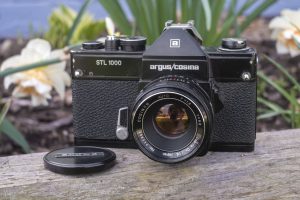
As the years passed, Argus branded cameras continued to be sold, but nearly all were rebadges of other cameras, such as the Argus/Cosina STL 1000 which offered nothing unique other than a new name and an even cheaper price.
Today, there are Argus collectors and there are German camera collectors and I doubt there’s much of a crossover between the two. Certainly cameras like the V-100 or the original Iloca model this was based off are appealing to someone, but for the collector looking for an interesting German Argus, it might be for you. There weren’t many of these cameras made, so finding them won’t be the easiest, but at least when you do, they shouldn’t be too expensive.
My Thoughts
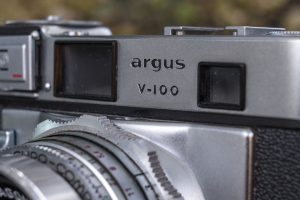
The thought of a German Argus intrigued me. An American company selling a German camera. Kodak did it with the Retina and those were pretty terrific, so how would Argus’s first (and only) European attempt fare? Thankfully, my friend Paul Rybolt was able to help me answer that question when he offered me this nice looking Argus V-100 for not only a nice price, but it was also the version with the faster Cintagon f/2 lens!
When it arrived, the camera felt unlike any other Argus I had ever held. In this case, I can’t go entirely by weight as many Argus cameras were heavy, in fact, the V-100 is over 120 grams lighter than a pre-war Argus C3. Unlike those Argus bricks however that are a combination of chrome plated metal and solid Bakelite, the Iloca built V-100 has a mostly stamped metal body, with only the slightest bits of plastic. The overall feeling of the camera is solid metal, but not overly heavy. I’d say it compares favorably to some of the lesser Retinas.
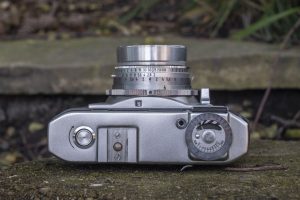
The top plate of the camera is pretty clean, with a small recessed pop-up rewind know, flash hot shoe, a threaded shutter cable socket, and the readout from the exposure meter. The front door of the meter has a log on it I don’t recognize, but it’s definitely not a Bewi or Gossen like I’ve seen on other German cameras of this era. Controls like the film advance lever, shutter release, and exposure counter are not present here, as they are located in other areas of the camera.
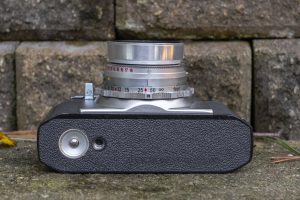
Normally when you find an uncluttered top plate of a camera, it means the bottom will make up for it, but not here. Flip the camera over and all you see is the rewind release button and an offset 1/4″ tripod socket. The V-100 is not especially heavy, so having a centrally located tripod socket isn’t exactly a requirement, but it is still curious to see it off to the side here. Although the camera body is made of black painted metal, the body covering which is present on the sides, back and bottom, is very plasticky feeling, with no give to it. I wouldn’t quite call it slippery, but it’s definitely one of the “less elegant” aspects of the camera.
Around back, in the upper left corner is a black plastic slider with a white arrow that serves two purposes, the first is to pop up the rewind knob for rewinding film, the second I’ll explain in a bit. Although mine was intact on this example, this little black slider is one of the few plastic parts of the camera, and while researching this camera, I found many comments from people whose slider had broken off, so be careful with it.
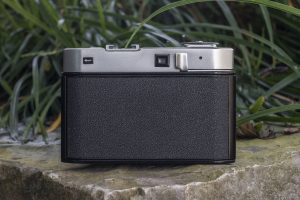
Off to the right is the rather small opening for the viewfinder. I am not a fan of cameras with viewfinders on the right as I am a left eye shooter and this feels unnatural to me. Also, for a camera released in 1958, the tiny size of the eyepiece is a bit of a disappointment, especially considering other American Argus cameras like the Autronic, C33, C4, and C44 cameras all had pretty large eyepieces. Finally there is the film advance lever, which wraps around from the back to the front of the camera. The throw of this lever is quite long. I’d estimate it to be around 200-210 degrees, making it a bit of a challenge to do in one single motion. Several smaller motions are not allowed as the lever will not return to it’s original position until after you’ve reached the end of it’s motion.
Finally, a very small hole in the back plate looks to be a zero adjustment for the meter. On mine and all examples of this camera I could find online, this hole was exposed to the elements which seems like a pretty bad idea, but perhaps it’s a sealed area away from the rest of the innards of the camera. I can’t believe that Iloca or Argus wouldn’t have designed a cover or some type of plug to cover his hole when the camera was new.
There’s not much to see on either side of the camera as both sides are rather symmetrical. There are also no strap lugs present, meaning that the only way to use a neck strap with the V-100 is to either use the original ever ready case, or use a tripod socket strap.
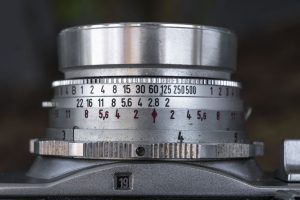
Looking down upon the top of the shutter and lens, we see all the typical things you’d expect to see on a leaf shutter rangefinder. The focus wheel is closest to the body and moves smoothly from the unmarked minimum focus distance all the way to infinity. The total rotation of the focus wheel is a little shy of 360 degrees which is great for precision, but bad for speed. You would not be able to go from minimum to infinity focus in one single motion, requiring you to reposition your hand to go all the way. Although this was common on pre-war and early post war cameras, by the time of the V-100’s release, this kind of thing was already out of fashion.
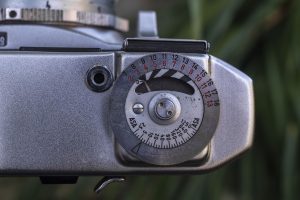
In front of the focus wheel is a stationary depth of field scale engraved in red numbers, and in front of that, the coupled shutter speed and aperture wheels. The Argus V-100’s uncoupled meter uses EV values which require you to transfer an EV reading from the meter to a scale on the side of the shutter ring. The meter has two EV scales, one in red from 2 to 13, and one in black from 7 to 18. The black numbers are to be used when the little door on the front of the meter is closed, and the red numbers when it is open. Regardless of which scale you use, whichever EV number the meter points at, you must turn the shutter speed dial so the EV number lines up with a little red dot on the side of the shutter. If you cannot reach this dot due to the aperture scale reaching this limit, or if you want to just choose your own combinations of shutter speeds and f/stops, you must pull back on a small tab on the side of the aperture ring. If this sounds confusing, it really isn’t once you get used to it, but the problem is, you’ll likely never get used to it as it’s a pain in the butt. I’ve never liked these sort of coupled EV scales on cameras. Some companies made them less bad than others, and I’ve certainly seen worse than on this V-100, but it definitely slows you down and does you no favors.
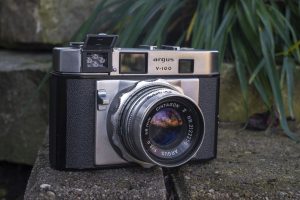
Off to the side of the lens and shutter is the front mounted shutter release. The location of this shutter release is well within reach of the photographer’s right index finger, but I found it to be just a tad too low to be comfortable. It’s certainly not hard to reach, but I suspect those with small hands might struggle a bit with it.
Beyond the shutter, the last thing you’ll see from up top is a small square window on a little platform above the shutter, but in front of the Argus V-100 logo. This window is the manually resetting exposure counter. The exposure counter is subtractive, showing how many exposures remain on your roll of film, so it is critical to reset it to the correct number each time you load in a new roll of film. The numbers 22 and 2 are highlighted in red as those are supposed to be the starting positions for loading in a 20 or 36 exposure roll of film. Since 24 exposure cassettes did not exist when this camera was made, if you used that, you would set it to 26 when loading in a 24 exposure cassette. The reason it’s two higher than the number of exposures is because you are supposed to advance through two frames after installing in a new cassette before taking your first image.
Now, I’ve mentioned resetting the exposure counter, but how do you do that? Come to think of it, there’s one critical part of the Argus V-100 that I would have almost certainly covered by now, yet I haven’t. Can you guess what it is?
The film compartment! Yes, how do you open the camera to load film in it? In my time reviewing cameras, I’ve learned it’s generally a bad idea to use definitive words like “always”, “never”, “best”, and “worst”, but in this case, I feel confident in saying the Argus V-100 (and the Iloca Rapid IIL it is based off), has one of the worst designs for opening the film compartment ever.
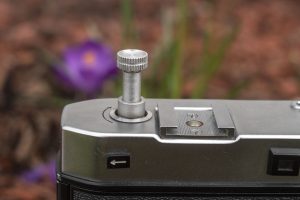
Remember that little black plastic slider on the back of the camera that pops up the rewind knob. Well, it turns out that knob has two positions. Normally, when moving that little slider in the direction of the arrow, the knob only pops up to it’s first position. You need to continue holding the black sider in the direction of the arrow while continuing to pull on the rewind knob to get to the second position. It will not do it on it’s own.
Okay great, the film compartment is open now, right? Nope. With the rewind knob up all the way, you must twist it in a clockwise direction to force the the left side of the camera, which doubles as a hidden latch, out of the way so the film door can come off. The film door is not hinged and is completely removable, revealing the film compartment.
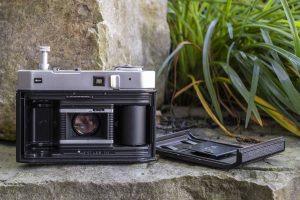
Film transports from left to right onto a very large and single slotted metal take up spool. The spool is as big as some clockwork wind up cameras, possibly suggesting that perhaps a motorized version of this camera was one planned. The operation of the take up spool is pretty ordinary, but it’s size is huge. Another oddity is that for how big it is, there’s only a single slot to attach the leader to. You’d think that if someone had a good reason to make the take up spool so big, they would have at least put in a couple extra slots to make film installation easier, but nope.
The rest of what’s here is pretty ordinary. A sprocket gear for keeping track of film spacing is above the film gate, an on the inside of the rear door is an ordinary black painted metal pressure plate. The pressure plate is not oversized and it has no divots or anything else to help minimize friction as film passes over it. The distance from the film gate to the take up spool and supply cassette is very short which means that less of the leader and tail of a cassette of film is waster, suggesting that it should be possible to get one or even two extra shots per roll of film. Finally, with no foam or felt light seals to degrade, the camera didn’t require any effort there to be ready to shoot.
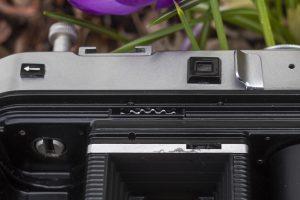
One final thing that you can see here is above the film gate, which is a large toothed wheel which is the exposure counter reset. Earlier, I mentioned the exposure counter must be manually reset and this wheel is how you do it. Of course the film door needs to be off to access it, so it’s very important to remember to reset the counter before attaching the door, otherwise you won’t be able to do it once you start taking photos. You can turn this reset wheel in any direction you wish to get it to where you need it to be.
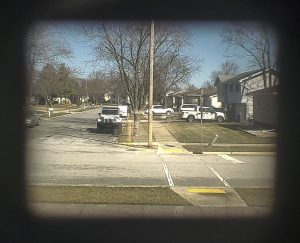 As I mentioned earlier, the eyepiece for the viewfinder is much smaller than most 35mm cameras from 1958. Looking through the viewfinder while wearing prescription glasses, I was unable to see the entire frame. There are no frame lines of any kind, nothing to indicate exposure or camera settings, just a plan rectangle with a rangefinder patch in the center. Thankfully, the rangefinder patch is rather large, compared to the rest of it and has enough contrast that I had no problem focusing the camera. For glasses wearers as myself, it’s nearly impossible to accurately frame the entire image, so my best advice is to not attempt any tight compositions. Take photos of things far away or closeups with a lot of headroom and you should be fine.
As I mentioned earlier, the eyepiece for the viewfinder is much smaller than most 35mm cameras from 1958. Looking through the viewfinder while wearing prescription glasses, I was unable to see the entire frame. There are no frame lines of any kind, nothing to indicate exposure or camera settings, just a plan rectangle with a rangefinder patch in the center. Thankfully, the rangefinder patch is rather large, compared to the rest of it and has enough contrast that I had no problem focusing the camera. For glasses wearers as myself, it’s nearly impossible to accurately frame the entire image, so my best advice is to not attempt any tight compositions. Take photos of things far away or closeups with a lot of headroom and you should be fine.
If you’ve never heard of this models before, handling the Argus V-100 is a strange affair. It does not look like any other American made Argus camera, nor does it feel like one. The camera has a heft and sense of density that suggest a German made camera, however it’s list of features, ergonomics, and viewfinder suggest a very primitive camera. So which is it, is this a quality German camera disguised in American clothing, or is this a cheap American camera that just happened to be made in Germany?
My Results
Fall was approaching as I was preparing to take the Argus V-100 out for it’s first roll, so I tapped into a large supply of Kodak Vision3 500T cinema film I have, thinking that the extra speed might help with lower amounts of light during this part of the year and also the normally vibrant colors of Vision3 film might work well with the fall color palettes. I’ve discussed this before, but for anyone not familiar, Vision3 is a cinema film with a protection Remjet layer that must be removed before developing. There are color ECN2 kits that can do this for you, or you can just use regular C-41 kits and remove it yourself by rubbing the wet film between your fingers. I chose the latter.
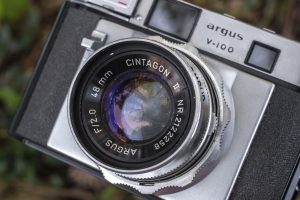
Looking at the images, the Vision3 film seems to have degraded a bit more than I had thought. It didn’t look terrible, but the grain was a little higher than I had expected, and several of the shots looked a bit washed out. Certainly not something I can blame the camera for.
Sharpness from the Rodenstock built Cintagon II f/2 lens is very good. Looking at images of fall foliage and the outdoor scenes, I don’t notice any significant softness near the corners, nor is there any vignetting, suggesting the lens has good coverage. Color accuracy is probably fine too, but to be honest, with expired 500 speed cinema film, looking for accurate colors really shouldn’t be a priority.
It is very clear that anyone buying this camera would have been attracted by it’s lens. The Argus V-100 takes fine pictures. The Rodenstock built Cintagon f/2 lens is definitely the highlight of this camera. Combined with the wide range of speeds offered by the Synchro-Conpur shutter, you should have no problem making wonderful photographs with this camera.
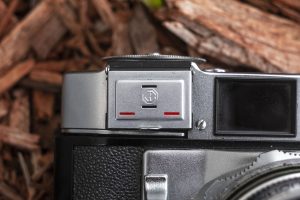
Unfortunately, that’s about the nicest thing I can say about it as the rest of the camera is plagued with problems. Cosmetically, the camera looks nice enough, but the body covering is so cheap feeling, it would be easy to mistake the camera for being made of plastic.
The nearly 360 rotation of the focusing, long throw of the wind lever, completely bizarre method for opening the film compartment, the location of the viewfinder on the right, and the inexcusably small viewfinder that is impossible to use with glasses is something that could have passed in the 1930s and 40s, and maybe even in the very early 1950s, but not 1958 when this camera first went on sale. Even more laughable was Argus’s original $161.15 list price of the camera with the f/2 lens. For that kind of money, you could have bought a long list of MUCH better German and Japanese cameras. At the bargain basement price that Argus eventually sold these for, they competed with Argus’s own American models, further showcasing the poor management decisions the company was making at the time.
I’ll stop short of saying the Argus V-100 is a bad camera, as under the right circumstances, it does what it’s supposed to do, but boy, is it a chore. Considering the original price for this camera and the year in which it was released, it’s no wonder why they’re so hard to find today as nobody wanted them back then!
Related Posts You Might Enjoy
External Links
http://camera-wiki.org/wiki/Argus_V-100
https://www.photo.net/discuss/threads/argus-v-100.263062/
https://camerashiz.wordpress.com/argus-v100/
http://photographytoday.net/?q=video/argus-v-100-german-made-camera-us-brand

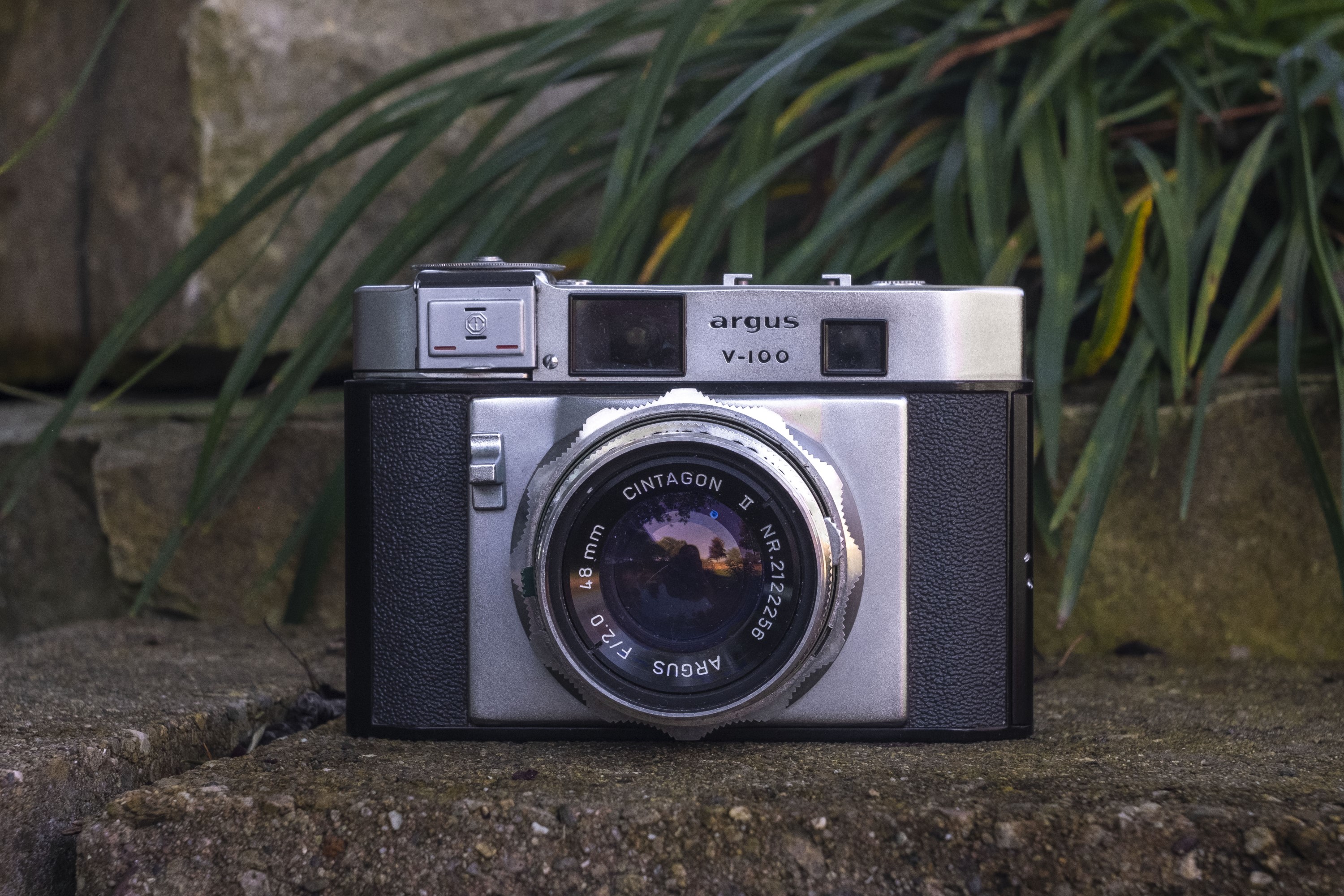
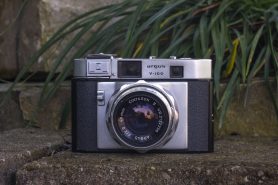
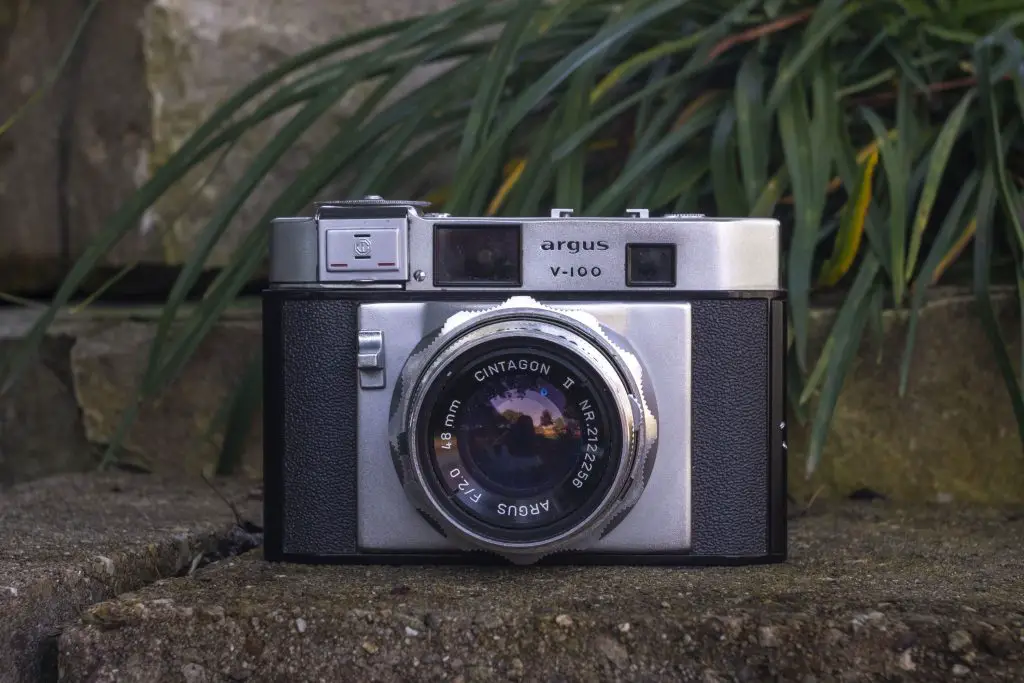
















Hi Mike! The light meter apparently was made by Metrawatt AG in Nuremberg. Here’s a link to a light meter instruction booklet with the same logo, courtesy of Mike Butkus. https://www.cameramanuals.org/flashes_meters/metraphot.pdf
I second your conclusions, Mike. The first Tower 52 I encountered, I came close to throwing deep into the woods, thanks to the well-kept secret of the film door latch.
I have a few Iloca cameras in my collection and when I first saw your camera my first thought was “It’s an Iloca” but Argus would not re badge a German camera, would they? But it seems they did.
Iloca cameras are very quirky. Hours of fun can be had playing the “Guess how the back opens,” game, and one of mine has the wind on lever on the left of the camera but the film is still loaded and travels in the normal direction. But having said that, they are usually solid and well made, as well as being reliable.
Another excellent review which has left me wanting an Argus V100 to go with my Iloca’s.
Yeah, I’ve played the “guess out the back opens” game multiple times with other people too! I have a second “bonus” Iloca review coming on Thursday to pair with this. Its another very uncommon model that’s also a rebadge by an American company! 🙂 It also has a strange method for opening the back, that’s similar, but not identical to the V-100. One thing I’ve read about the Rapids though is that black lever on the back that releases the rewind lever, is made of plastic and can break off. If it breaks off, there’s no way to ever get the back open! What a silly design!